#car dependency
Explore tagged Tumblr posts
Text

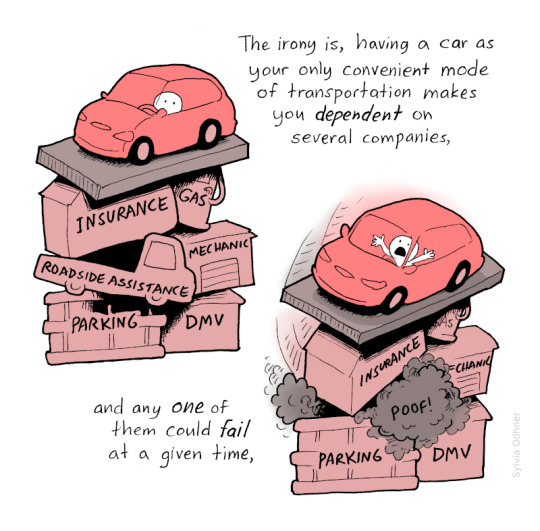
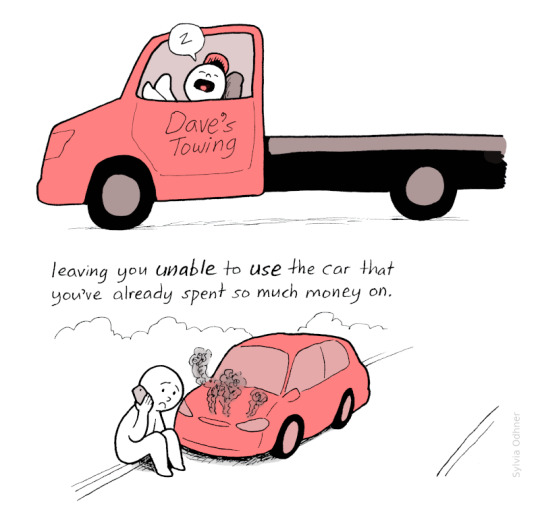

Cars and Independence
My Patreon
Update: This comic has received a lot of both positive and negative attention, and I decided to post a follow-up comic to address some of the criticism: Revisiting Independence
24K notes
·
View notes
Text
Paving over cities for automobile traffic has ruined peoples' ability to get around. We gotta stop doing this.
#car dependency#city planning#urban planning#accessibility#walkable cities#fuck cars#obligatory not cars as a whole but car dependency and systemic preference of automobile travel over all other forms of travel
31 notes
·
View notes
Text
youtube
Not Just Bikes' latest video covers how big-box retailers bankrupt cities:
unneeded government subsidies
new expensive sprawl infrastructure
enforced car dependency (to the tune of $12k/year in ownership costs per person)
convoluted building ownership structures and restrictive land use contracts that prevent competitors from opening up when a store closes down
claims that the buildings are so shoddy that they're worth nothing for tax purposes
the fact that they generate much less tax revenue per acre than traditional diverse Main Streets and downtowns, making them unproductive (particularly when municipalities are loath to increase property taxes on residents)
the fact that all the profits are siphoned elsewhere, in many cases out of the country itself
the fact that most of the products aren't made locally, so the local economy gets nothing
the general effect of big box retailers on traditional main streets, i.e. the bankruptcy and destruction of most retail categories
the way they underpay most employees, so they're dependent on SNAP benefits, which, in some towns, they can only spend...at the same store that underpays them.
10 notes
·
View notes
Text
Made some silly MTG cards satirizing car dependent suburbia
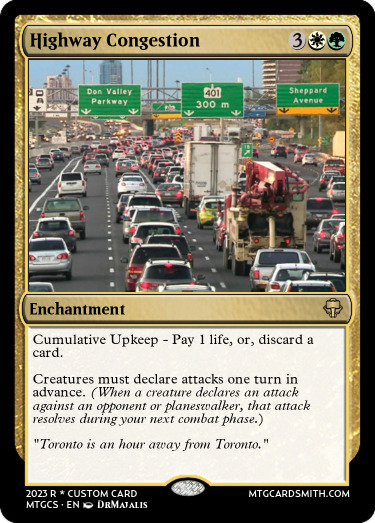
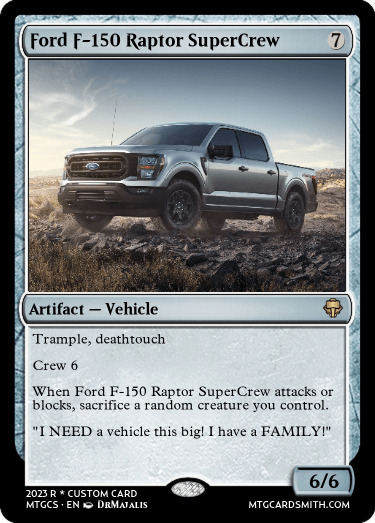
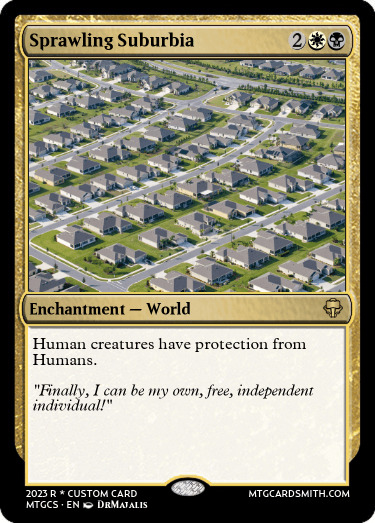
155 notes
·
View notes
Text
The car is a tool. A tool that is useful in specific situations. Even in a world where driving is not the dominant mode of transportation there will still be some middle distance trips where its the best option. They're not supposed to be fucking everywhere. They are good for certain situations, but it is the structuring of the US American transportation system entirely around the car that causes so many collisions, pedestrian deaths, pollution, and a million other issues. Sometimes online when people are talking about these things I will see someone will say that the REAL problem is PHONES, and there needs to be harsher punishments for offenders like suspending licenses. But in a country that basically requires both a phone and a car that is a short-sighted "solution" that is not going to actually help anyone. US driving laws are essentially designed to be broken, so distinguishing between "criminals" and other drivers is functionally useless. Cops can follow you around for 5 minutes and find some kind of driving infraction to pull you over for, which is most frequently used to racially profile Black people. Even if you could magic away all distracted driving, pedestrian deaths and car crashes would still happen at extremely high rates because it is the physical real-life infrastructure that exists which causes these things to happen, not individuals who may or may not be paying enough attention. Over 50% of car trips are a distance of 5 miles or less. The necessity for every person to have a car is artificial, and was created. It is absurd to expect every single person to independently operate their own high speed machine and be perfect in constantly pay attention, especially when road design itself encourages high speeds and considers pedestrians an obstacle to moving as many cars as possible as fast as possible. Multiple running representatives in my area have "traffic calming measures" as part of their platform, everyone fucking hates traffic! The solution to these problems is to use these tools for when they're ACTUALLY FUCKING USEFUL! and stop centering EVERYTHING AROUND THEM!
#my rant#my txt#all of this maybe feels a bit disjointed but i have been thinking about all these things simultaneously lately#car centric infrastructure#car dependency#anti-cars#i can provide more links to other things but i couldnt really find places to include them#us politics
17 notes
·
View notes
Text
In the bike lane strait up doingg "it"
And by "it" haha, let's justr say, freaking out :)
at the inadequate infrastructure that has been handed to me by my city :))
25 notes
·
View notes
Text
An important example of how adultism harms adults is that riding a bike is rarely respected as a legitimate mode of transportation and bikes are often treated as "children's toys" rather than real vehicles. There's a general assumption that the only reason an adult would ride a bike as their unironic primary mode of transportation is that they can't afford a car. And street designs prioritizing drivers over cyclists and pedestrians makes everyone less safe.
10 notes
·
View notes
Text
the urge to write an entire essay about public transportation (trains and boats) and how america was built off of the backs of it and the lower class workers who laid the dock foundation and rails is so strong right now. throw in a little passage or two about how the urbanization and following dependence on cars is destroying their history and accessibility for everybody
needless to say the urge is strong
#boat#cars#urbanization#america#american politics#car dependency#trains#travel#eco punk#cities#accessible travel#essay#railroad and boat truther for life#down with cars
65 notes
·
View notes
Text

Hostile architecture fucks everyone over, and instead of doing anything at all to help people get back up on their feet, states would rather just bus them off somewhere else and hope other states deal with it. All while making public spaces worse to be in and making them inaccessible to people with disabilities.
Something I also want to bring up since it also fucks over the homeless.. Why the fuck are most of our cities so car-centric? Like the answer has to deal with some racist policies that were implemented that I can get into in just a second but. Genuinely, being forced to drive and own a car makes me livid.
Public transportation is terrible compared to what it could have been, and not just because we don't use it. Car lobbyists have invested so much into crippling public transit to the point where nobody wants to use it. To get to work on time, I'd have to wake up 2 and a half hours before work, catch a train, and a bus and that's assuming neither have any delays.
But not only that, so many of us live in areas where we are not in walking distance to an actual supermarket.. Our communities have been run through by high ways created by racist policies whos only plan of action was to destroy black communities for generations to come.
So many low income communities are within food desserts because the only thing in walking distance is 3 different fast food chains and a fucking dollar general. Dollar stores take up spots from actual super markets and because of that, if you actually want to pick up groceries you essentially NEED a car to get them.
Lastly, back to why i hate cars so much, everyone is expected to have one and yet unless you're well off you most likely can not afford to purchase a newer vehicle. So we deal either deal with hoopties or take on debt to have a reliable vehicle just so we can have the privilege of not pissing half our day's pay away taking an uber to and from work and funny enough this affects EVERYONE
White america would gladly shoot itself in the foot if it means crippling black folks rather than just live in coexistence, and this just ONE example of this.
#politics#public transit#car dependency#public transportation#anti blackness#oppression#activism#rambles#rant post#discrimination#black tumblr
17 notes
·
View notes
Text


Barrett Pkwy, Cobb County. I grew up nearby & worked at Town Center Mall for a couple of years. I also got to see this land when it was still fields & forests, before the commercial development came.
We have to see this development style as a mistake. As a wound on the land. I truly believe that's a necessary step in working toward a less car-dependent style of development even in the suburbs.
15 notes
·
View notes
Text
example of how American suburbs are designed to be car dependent
#example of how American suburbs are designed to be car dependent#examples#for example#example#videos#video#car dependency#electric vehicles#unusual vehicles#vehicle transport#autonomous vehicles#vehiclemaintenance#vehicle#fast cars#classic cars#electric cars#luxury cars#cars#car#automotive#grocery#groceries#grocery store#grocery shopping#grocery delivery#grocery haul#shops#shop small#shop#class war
11 notes
·
View notes
Text
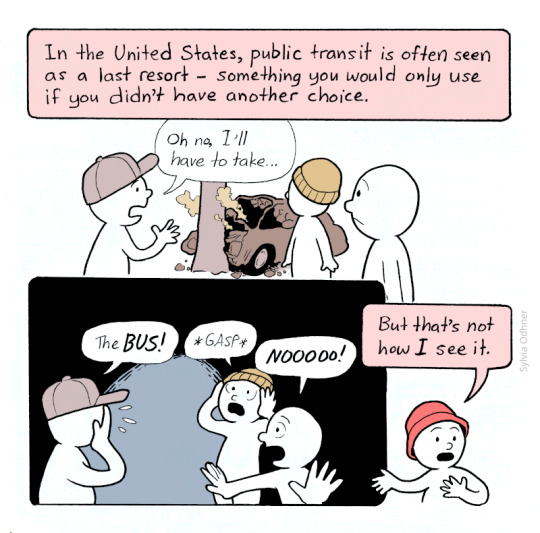
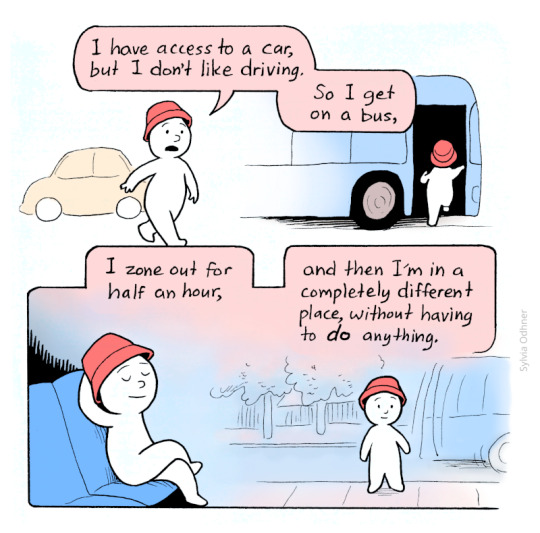
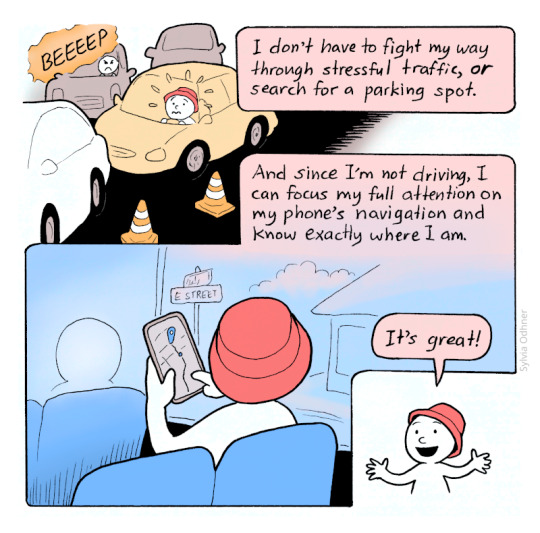

Public Transit Is an Under-Rated Experience
Public transit is the underdog in the United States, and we need to collectively invest in it if it's going to survive. If you agree, I recommend getting involved with transit advocacy groups in your area, like Transit For All PA for fellow Pennsylvanians.
120 notes
·
View notes
Text

Pretty much.
#car dependency#built environment#engineers#urban planning#fuck cars#*fuck car dependency#and designing everything for vehicle speed at the expense of safety#comics#funny#(i had a thing written here but tumblr fucked my other tags so i deleted them smh)
10 notes
·
View notes
Text
The historical lie that I recall learning in museums, in history books and in classrooms, was that the status quo—namely car priority everywhere, driving everywhere, people deferring to drivers if they're walking or if they're riding a bike—that that status quo was the democratic choice, the popular preference, or the consumer demand in the marketplace. Frame it how you like. And I think what we've really found instead is the fact that Americans did not ever choose car dependency. That world was never the product of mass preference. And the auto industry groups that pushed for that world are the best proof that it wasn't the democratic choice. Their own conversations, which I've read in detail, their internal conversations, are full of statements like, well, how do we possibly overcome this mass preference for riding the streetcar and for walking? I recall reading one conversation between industry insiders in the 1930s, where they're wringing their hands over the fact that lots of people in big cities like Chicago and Boston, who could easily afford a car, were not buying one. And so they sat around and thought about, how do we convince people that they need a car? One of the answers they came up with was, well, if we build expressways through all of our big cities, then people will need a car to get around. And it was not subtle.
— Peter Norton, Criminal Podcast #267, "Right Of Way"
11 notes
·
View notes
Text


Imagine a future where trolleybuses do all the shit like deliveries and waste collection. The trolleybus possibilities are endless until the line ends
39 notes
·
View notes
